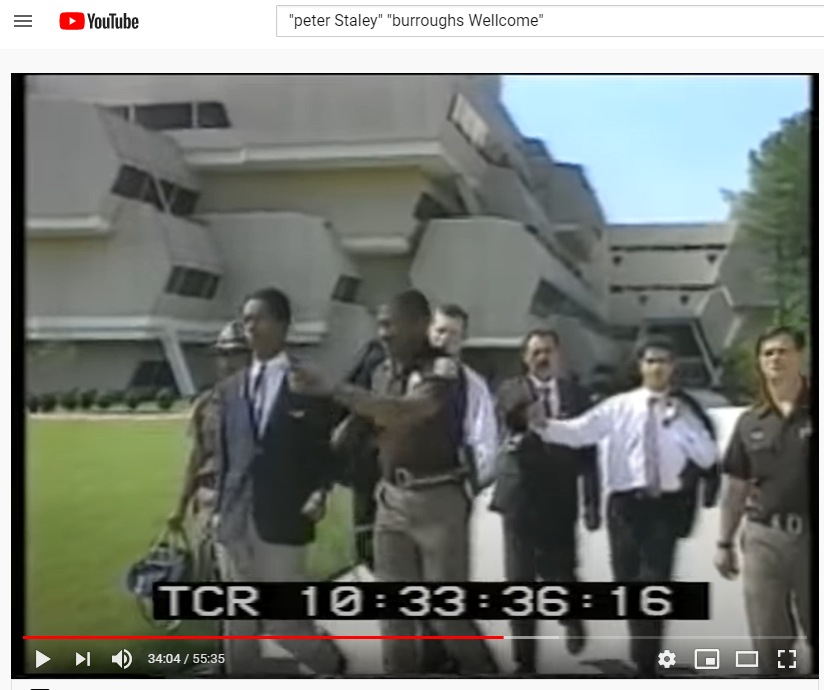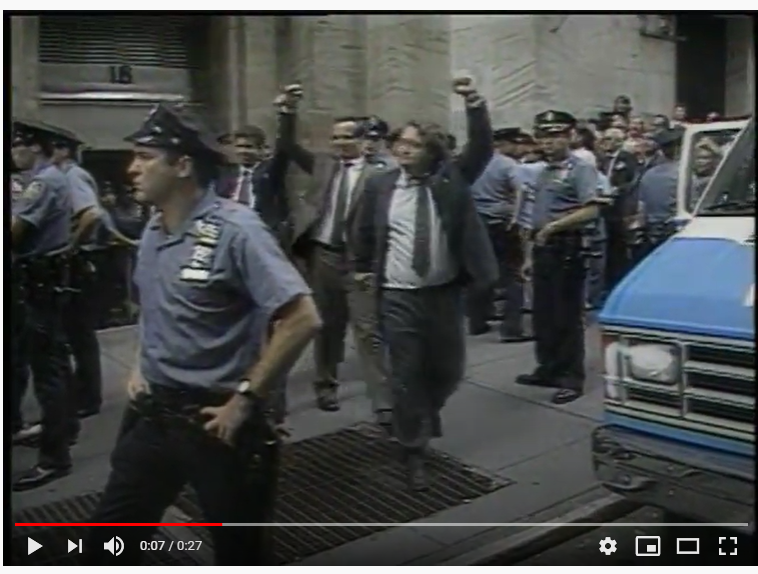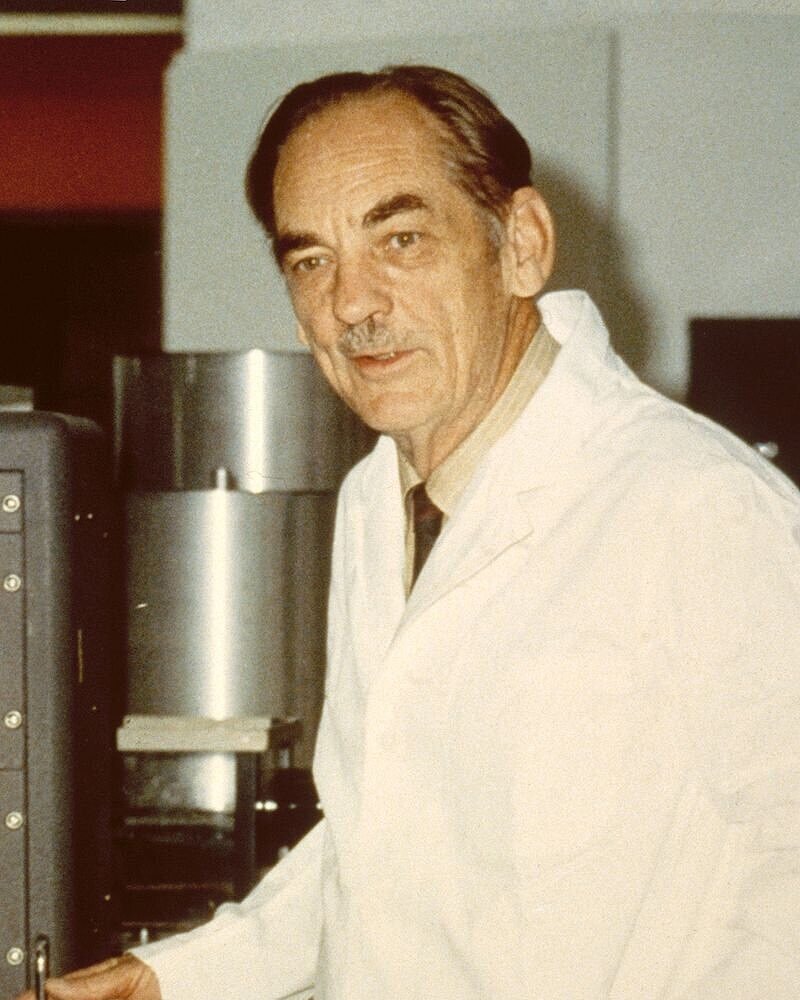Kate Wagner’s essay—defending Paul Rudolph’s Burroughs Wellcome Building, and taking on the shallowness with which great architecture is often devalued—opens with a dramatic view of the Burroughs Wellcome Building by the distinguished architectural photographer Joseph Molitor. Image courtesy of Joseph W. Molitor architectural photographs collection. Located in Columbia University, Avery Architectural & Fine Arts Library, Department of Drawings & Archives
A VOICE FOR SANITY IN ARCHITECTURE—LIKE NONE OTHER TODAY
Who is the most incisive, clear-eyed, and forthright critic on today’s architectural scene?
As an irrepressible voice for architectural sanity, KATE WAGNER has few rivals. Thus we were struck (and delighted) by her recent, brilliant defense of Paul Rudolph’s Burroughs Wellcome Building—one of the architect’s most exciting and masterful designs, which is now threatened with demolition—in her essay, “This Brutal World”
A sample image from the McMansion Hell website, in which a photo of a McMansion is analyzed by Wagner.
For those not familiar with Kate Wagner’s work, it’s always good to recount that she first came to prominence with her take-no-prisoners website, McMansion Hell—a space where her talent for giving undiluted assessments of the pretentions, impracticalities, and wasteful tastelessness of “McMansions” (and the culture that produced them) had ample space to be displayed.
If you’re not already an admirer of her analyses, this sampling will give you and idea of Wagner’s direct-as-nails rhetoric (as applied to one of the houses she was critiquing on that website):
“If you combine all of the insipid elements of the other houses: mismatched windows; massive, chaotic rooflines; weird asphalt donut landscaping; pompous entrances, and tacked on masses; you’d get this house. The more one looks at this house the more upsetting it becomes . . . . What sends this one over the top is its surroundings: lush trees and clear skies that have been desecrated in order to build absolute garbage.”
But her writings and wise advocacy have not just been about spotlighting overcooked (and undertalented) design. She has focused upon other vital issues such as land use, urbanism, residential space planning, and the history of architectural styles. Wagner has been a featured writer in Architectural Digest, The Atlantic, Huffington Post, Curbed, and other venues—and now can be read in The New Republic.
The essay appeared in the September 29, 2020 on-line edition of The Architect’s Newspaper-East.
DEFENDING PAUL RUDOLPH’S WORK—AND THE TREASURES OF GREAT ARCHITECTURE
Her essay, “This Brutal World” went well beyond considering the fate of that great building, Burroughs Wellcome—for she also offered a powerful attack on the cultural/economic world-view which places so little value on our country’s national treasures of architecture.
She starts by sharing her first powerful encounter, as a youngster, with a Paul Rudolph building: the amazing (and now disfigured) Orange County Government Center, in Goshen, NY—and how that impacted her entire life.
The Orange County Government Center, in Goshen, NY—as designed by Rudolph (and before its present disfigurement). Image courtesy of the Massachusetts Institute of Technology, photograph by G. E. Kidder Smith
“Many years ago, long before I became an architecture critic, I was a 14-year-old stuck in the back of a Buick crossover whose driver, my mother, had taken a wrong turn while looking for the Goshen, New York, Dunkin Donuts. We ended up in the parking lot of the most extraordinary building I had ever seen—Paul Rudolph’s Orange County Government Center, more commonly known as the Goshen Building.”
“. . . .Despite the outward signs of disrepair, the breath seized in my chest and as my eyes drifted over the compression and expansion of the building’s extruded masses, I realized that I had stumbled upon something extraordinary. I asked my mother, who grew up in Goshen and was visiting relatives there, if she knew what the building was. She rolled her eyes and said, ‘Ugh, that’s the DMV.’”
“When we returned home to North Carolina from our family reunion, I took to the computer and searched for the Goshen, New York Department of Motor Vehicles. Some clicking got me through to the Wikipedia page for Paul Rudolph, a mid-century architect who was once the Dean of the Yale School of Architecture. It was at that point I fell in love and became obsessed—not only with Rudolph’s work, but with architecture as a whole.”
“My life is marked by a threshold of before and after Paul Rudolph.”
At right are some of the buildings which Kate Wagner mentions in her article: architecture by Paul Rudolph that has been demolished, damaged, or—like Burroughs Wellcome and the Boston Government Service Center—are currently under threat. From top-to-bottom: Shoreline Apartments, Micheels Residence, Christian Science Center, Boston Government Service Center, Burroughs Wellcome.
And Kate Wagner tells of the actions that she began taking:
Photographic credits for the above five images, from top-to-bottom: Image courtesy of Joseph W. Molitor architectural photographs collection. Located in Columbia University, Avery Architectural & Fine Arts Library, Department of Drawings & Archives; © The Estate of Paul Rudolph, The Paul Rudolph Heritage Foundation; Image courtesy of the Massachusetts Institute of Technology, photograph by G. E. Kidder Smith; Archives of the Paul Rudolph Heritage Foundation; Image courtesy of the Massachusetts Institute of Technology, photograph by G. E. Kidder Smith
“In 2010, I had stumbled on a news article about the pending demolition of the Goshen Building. I was devastated.”
“I got into many arguments with my mother, who at the time shared the majority opinion of Goshenites and thought the building an unlovable eyesore. I decided to do everything that I, a high-school sophomore hundreds of miles away, could to save it. I wrote letters to Goshen politicians, my first-ever writings on architecture; I donated my babysitting money to Docomomo. . . .I was a freshman in college. I was beginning graduate school when Orange County finished lobotomizing Rudolph’s building with a horrific contemporary addition. Reflecting on the loss years later, I can’t help but be upset.”
Her article goes into Rudolph’s career, but then notes the threats to the survival of other parts of his oeuvre—the latest of which, in jeopardy, is Burroughs Wellcome.
“Rudolph designed numerous houses around the country and a great many important projects including the Yale Art & Architecture Building, the Boston Government Service Center, and numerous buildings for the University of Massachusetts at Dartmouth. However, Rudolph lived long enough to see the tide turn against modern architecture, and his reputation tarnished as a result. The wrecking ball soon tore through Rudolph’s portfolio. Riverview, Buffalo’s Shoreline Apartments, houses in Connecticut, Rhode Island, and Florida, and the Christian Science Organization Building rank among the fallen, while the Boston Government Service Center is under grave threat. The latest victim in this saga of devastation is his Burroughs Wellcome Co. Headquarters and Research Building in Durham, North Carolina.”
There is a great deal more in Kate Wagner’s fine essay (and we urge you to read it—in full—here.) But it might be good to close by sharing excerpts from some of the points she makes about the larger issues to which she brings her powerful focus:
“I. . . .think that I am a fool for believing that the tide of public opinion has changed enough to have prevented a major work of architecture from being carelessly demolished. I am an even bigger fool for believing that public opinion is what stops the destruction of works of art—that the core problem is awareness rather than money. . . .It doesn’t matter if Burroughs Wellcome is priceless, unique, a work of spatial, formal brilliance. To its owners it is a burden, a resource sink, a negative sign on a spreadsheet. . . .It is an asset of business, an object whose use-value will always be subornidated to its exchange value. . . .”
“I write this as a means of processing the impending loss of a building I care deeply about as a historian and as an individual, but also because I believe that the preservation community is facing a hard truth: Their battle is not against one bulldozer-happy company or developer but against an economic system that reduces architecture to an asset that sits upon an even more valuable asset—land. The court of public opinion has no say over the rule of the wallet, and even the success of a decade-long campaign to recuperate Brutalism from the trash heap of history cannot alone save Burroughs Wellcome from the wrecking ball. Time repeats itself—I once sat in a chair in my room on a laptop typing up letters and school assignments devoted to saving the Goshen Building; ten years later, I sit in my office and type this essay about mourning another building by the same architect. Both times, despite it all, grief is mixed with hope.”
Note: We hope that the demolition of the Burroughs Wellcome Building is not inevitably “impending”—and the Paul Rudolph Heritage Foundation is fighting to save it. Please see below about how you can help.
The threat to Burroughs Wellcome is part of a pervasive problem, as is illustrated here: the same web-page in The Architect’s Newspaper (on which Kate Wagner’s article appeared) also showed links to other articles—each of which is about the demolition of good and/or interesting modern buildings.
YOU CAN HELP SAVE BURROUGHS WELLCOME !
The Burroughs Wellcome building is threated with imminent demolition.
It’s loss would be a disaster—a titanic waste of our nation’s cultural heritage. Remember:
When a great building is destroyed, there are no second chances.
NOW— THERE ARE TWO THINGS YOU CAN DO:
Sign the petition to save Burroughs Wellcome— Please sign it here.
We can keep you up-to-date with bulletins about the latest developments. To get them, please join our foundation’s mailing list: you’ll get all the updates, (as well as other Rudolphian news.)—you can sign-up at the bottom of this page
Burroughs Wellcome’s famous, soaring entry lobby, which Kate Wagner had heard the present owners were going to use as part of a visitor’s center. That was before their current intentions, for demolition of the building, became known. Image courtesy of the Massachusetts Institute of Technology, photograph by G. E. Kidder Smith









































































































































































